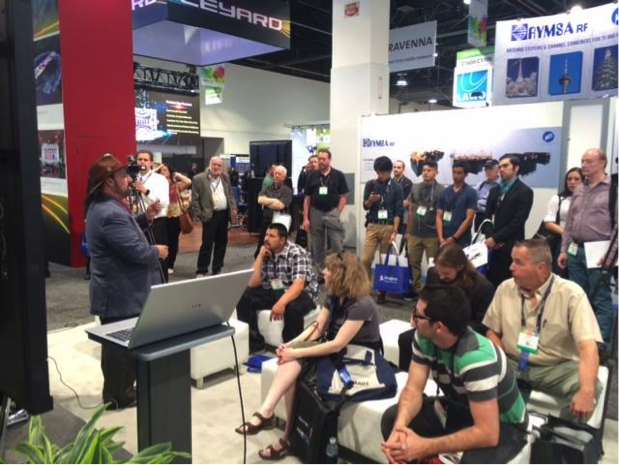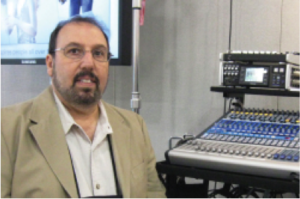A skilled Hollywood sound acquisition specialist who worked on classic television shows like St. Elsewhere and films including Platoon and Used Cars, Fred Ginsburg uses his professional experience as a Production Sound Mixer and Sound Designer to refashion the educational curriculum of sound for picture. Ginsburg offers workshops throughout the country, helping students establish a base of knowledge about this critical but under-taught aspect of cinema and television sound.

Fred Ginsburg presenting at NAB 2014. If you're at this year's NAB show in Las Vegas, stop by Booth C1742, where Fred Ginsburg will be answering questions.
We were lucky enough to sit down with this legendary sound specialist and ask Fred a few questions about his craft and the sound industry. Check out part one of our four-part Q&A with Fred Ginsburg!
A-T: How do you feel the audio industry, specifically in Hollywood, has changed in the past 20 years?
 FG:
FG: In terms of gear, the two major changes have been in the way of multi-track recorders and much more reliable wireless mics. Two decades ago, Hollywood was still working mainly in two-track, and just beginning to experiment with four-track.
Of course there have been major changes in workflow. We evolved from sprocketed film cameras to electronic cinema. Take lengths went from a minute or two, in film — to ten or twenty minutes continuously. All those longer takes are actually beginning to take a toll on boom operators, especially as they get older.
More and more producers believe too much in technology and not enough in people skill. New sound mixers are too often hired onto shows to simply act as “recordists”. They are supposed to hang lots of radio mics on all of the cast members, and then just record individual “ISO” tracks of everything. Those tracks then get tossed into the Editor’s lap, and it is now up to the picture cutter to sort everything out and pretty much do a pre-dub or mixdown of every take, just to hear what may be usable.
Fortunately, there are some audio hold-outs who still “mix”. Although we deploy a rack of radio mics and record ISO’s of the talent, we still rely a lot on our booms and planted mics in addition to the lavs in order to provide a live mixdown that serves as the production track for dailies and picture edit. If done right, the sound editors rarely have to tap into the ISO’s later on.
A-T: How do you see the industry changing in the next five years?
FG: Multi-track recording systems keep getting more sophisticated. Dante digital recording interfaces offer 24 and 48 track systems in compact and affordable configurations. Radio mics keep improving.
I foresee greater strives in the way of DSP assisted shotgun mics that use multiple capsule arrays along with software to improve directionality and background noise rejection. You may recall that Audio–Technica was the first in that area, with their AT895 adaptive array mic system.
What I fear, though, is that more and more lower budget or indie producers are pressuring the new generation of sound mixers to keep placing more emphasis on wireless lavs, and less on the standard tools of booms and planted mics. Ironically, these producers expect sound mixers to include more and more hardware in their location packages — at the same time refusing to pay realistic rental rates for all that “free” gear!
If new sound mixers cannot earn back their investments in high tech tools, nor see paychecks substantial enough to support a family — our industry could easily become a revolving door. Newcomers will sacrifice all, in the beginning, for the opportunity to work in the film industry — but after a few years at most, may have to drop out in order to join the middle class.
A-T: If you wanted to get into the Hollywood sound industry, is there any advice or encouragement that you can give people trying to get their foot into the door?
FG: To begin with, learn as much as you can about everything related to film/video production. Hollywood is not a training school; once hired, you are expected to be able to get the job done!
Don’t limit your education to just one area. Learn editing, post production sound, lighting, even camera. The better than you understand the workflow on the set, and what happens to your tracks during post — the better a location mixer you will be.
You need to be familiar with lighting in order to deal with boom shadows. A working knowledge of Pro Tools and Izotope RX4 Advanced (noise reduction software) is essential so that you understand how your tracks will be edited, intercut, matched, tweaked, and mixed.
Offer to hang out, for free, at the sound rental houses. It will give you an opportunity to really learn the hardware, as well as to meet freelance sound people. Pick as many brains as you can; there is so much out there to learn, and it keeps changing all the time.
NEVER accept any job offer that would force you to compromise on the quality of your delivered soundtrack. There are no subtitled explanations during the closing credits that allow you to make excuses like, “we had cheap sound equipment” or “I didn’t have a boom operator and had to mix and boom all at the same time”. Audiences (and potential clients) will only know that the movie sound was good or bad, and that you were responsible. Make sure that you protect your reputation at all times.
Start by getting as much time on the set and behind the mixing panel as you can. Student thesis films, non-profits, indie projects, deferred pay, labors of love, charitable causes, and so on. Lots of filmmaking, but little or no money. That is okay in the beginning. It is the continuation of your education. There is no substitute for hands-on experience. Think of a doctor doing a residency.
However, once you achieve a level of competency — then stop working for free or sub wages. Establish a fair market rate, and stick to it. If you come down on your daily rate for one client, then everyone will expect the same discount. If you absolutely must adjust your invoice, then reduce what you are billing for your equipment rental. It is easier to explain away one-time equipment discounts with a future client, then to back peddle over your daily salary expectations.
Try to always go out with a boom operator. It is near impossible to do feature quality audio if you are working as a one-man band. Before long, you will be pegged as a hard-working, reliable, capable, ENG or docu/reality sound recordist, good for those low budget “keeps the doors open” contracts. But the first time that your longtime client gets a chance to go Hollywood, they will bypass you for whom they consider to be a bona fide “feature film” sound mixer.
To Be Continued!
Interested in learning more from Ginsburg? Check back soon for part two of our Q&A with Fred Ginsburg. Also, stop by the Audio-Technica Booth (C1745) at NAB 2015 to visit with Fred and experience hands on training via his realistically rigged and fully functional soundcart.

 FG: In terms of gear, the two major changes have been in the way of multi-track recorders and much more reliable wireless mics. Two decades ago, Hollywood was still working mainly in two-track, and just beginning to experiment with four-track.
Of course there have been major changes in workflow. We evolved from sprocketed film cameras to electronic cinema. Take lengths went from a minute or two, in film — to ten or twenty minutes continuously. All those longer takes are actually beginning to take a toll on boom operators, especially as they get older.
More and more producers believe too much in technology and not enough in people skill. New sound mixers are too often hired onto shows to simply act as “recordists”. They are supposed to hang lots of radio mics on all of the cast members, and then just record individual “ISO” tracks of everything. Those tracks then get tossed into the Editor’s lap, and it is now up to the picture cutter to sort everything out and pretty much do a pre-dub or mixdown of every take, just to hear what may be usable.
Fortunately, there are some audio hold-outs who still “mix”. Although we deploy a rack of radio mics and record ISO’s of the talent, we still rely a lot on our booms and planted mics in addition to the lavs in order to provide a live mixdown that serves as the production track for dailies and picture edit. If done right, the sound editors rarely have to tap into the ISO’s later on.
FG: In terms of gear, the two major changes have been in the way of multi-track recorders and much more reliable wireless mics. Two decades ago, Hollywood was still working mainly in two-track, and just beginning to experiment with four-track.
Of course there have been major changes in workflow. We evolved from sprocketed film cameras to electronic cinema. Take lengths went from a minute or two, in film — to ten or twenty minutes continuously. All those longer takes are actually beginning to take a toll on boom operators, especially as they get older.
More and more producers believe too much in technology and not enough in people skill. New sound mixers are too often hired onto shows to simply act as “recordists”. They are supposed to hang lots of radio mics on all of the cast members, and then just record individual “ISO” tracks of everything. Those tracks then get tossed into the Editor’s lap, and it is now up to the picture cutter to sort everything out and pretty much do a pre-dub or mixdown of every take, just to hear what may be usable.
Fortunately, there are some audio hold-outs who still “mix”. Although we deploy a rack of radio mics and record ISO’s of the talent, we still rely a lot on our booms and planted mics in addition to the lavs in order to provide a live mixdown that serves as the production track for dailies and picture edit. If done right, the sound editors rarely have to tap into the ISO’s later on.